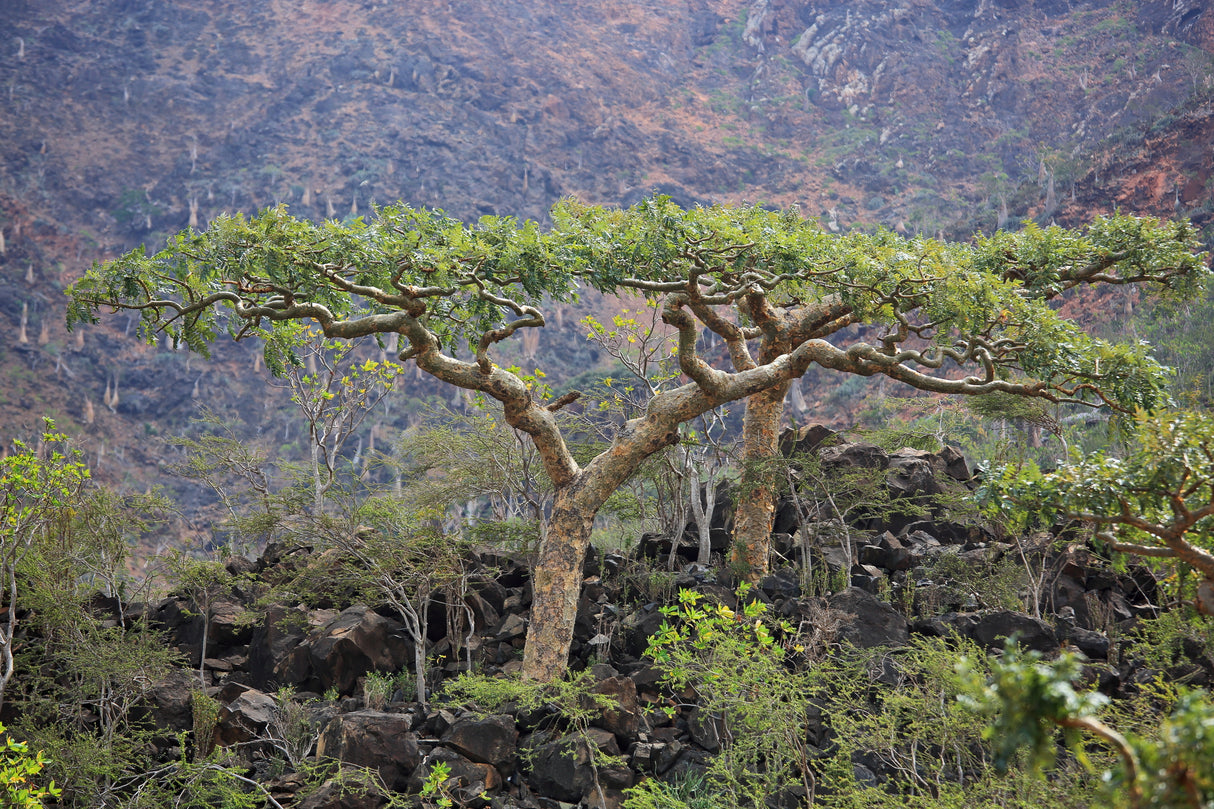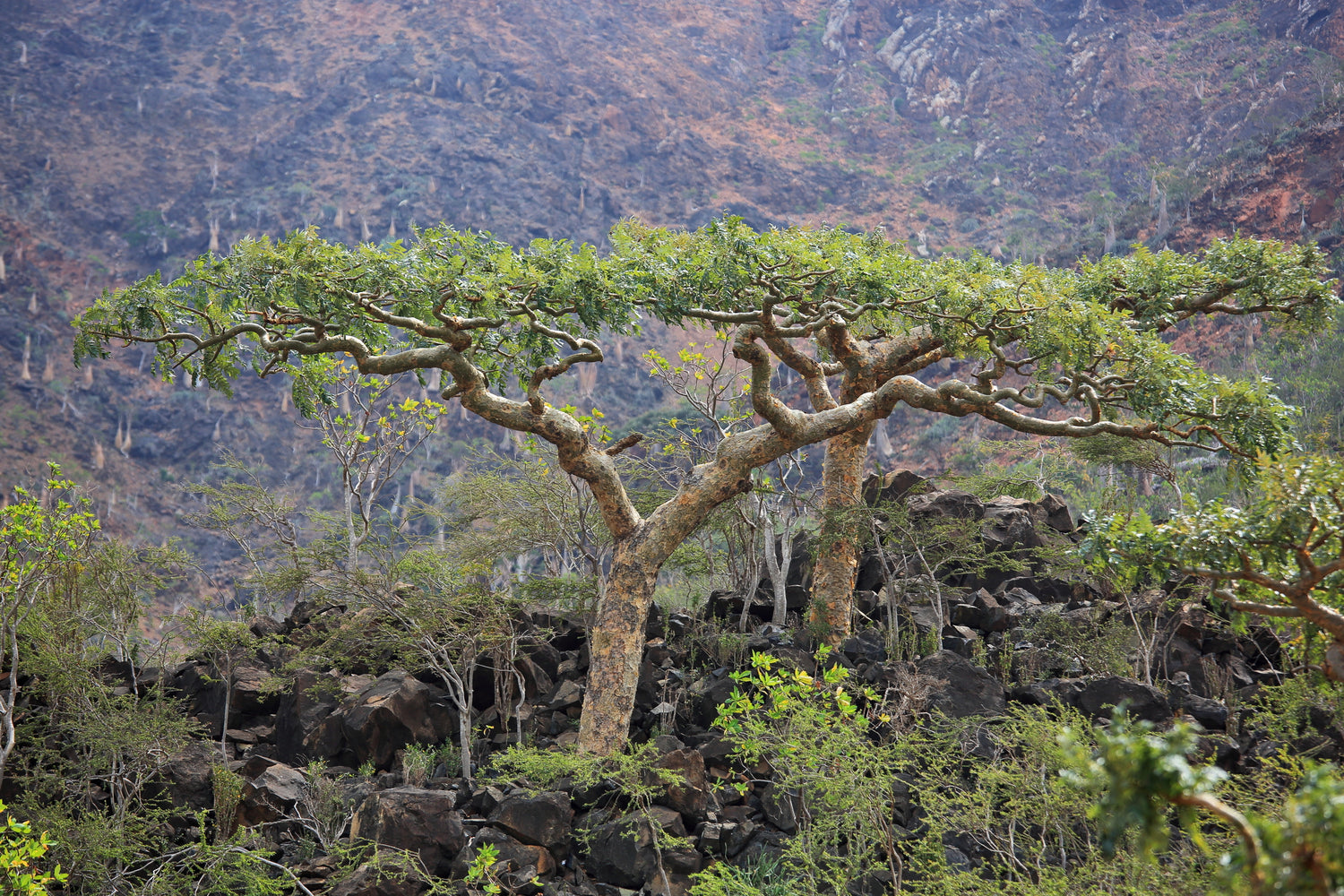Description
Description
The Boswellia carteri (syn. Boswellia sacra), or Frankincense Tree, is a small, hardy deciduous tree renowned for its aromatic resin, which has been prized for centuries in religious ceremonies, traditional medicine, and perfumery. Growing up to 5 meters, it features a gnarled trunk, papery bark, and pinnate, green-gray leaves. During the dry season, it produces small, star-shaped white flowers.
Native to arid regions of the Arabian Peninsula and northeastern Africa, this tree thrives in extreme conditions, making it ideal for dry, rocky landscapes and conservation projects.
Specifications:
- Height: 2–5 meters
- Width: 3–4 meters
- Native to: Arabian Peninsula (Oman, Yemen) and northeastern Africa (Somalia)
- Foliage: Small, pinnate, gray-green leaves, deciduous in drought conditions
- Growth rate: Slow
Conditions:
- Soil: Thrives in well-drained, rocky, or sandy soils; tolerates extremely poor soil
- Light: Full sun
- Water: Very low; highly drought-tolerant once established
- Climate: Thrives in arid and semi-arid regions
Additional Features:
- Resin: Produces fragrant resin, harvested by carefully cutting the bark; valued for its use in incense, essential oils, and traditional medicine
- Flowers: Small, white, star-shaped blooms appear during the dry season
- Uses: Ideal for arid landscaping, reforestation, and cultural or spiritual plantings
- Spacing: Plant 3–4 meters apart for individual growth or grouped plantings
- Low Maintenance: Requires minimal care; prune deadwood occasionally
- Pest Resistance: Naturally pest-resistant and highly resilient
- Cultural Significance: Revered for its resin in ancient rituals, perfumery, and medicine
- Environmental Benefits: Helps stabilize rocky soils and supports biodiversity in arid regions
The Frankincense Tree is a symbol of endurance and tradition, perfect for adding historical and ecological value to dry landscapes and conservation projects.
Delivery Information
Delivery Information
We offer flexible delivery options to ensure your tree arrives in perfect condition, whether you're located nearby or on the other side of the world.
- Domestic Deliveries:
We provide reliable delivery services across the country, utilizing our fleet of specialized trucks and train freight networks. Whether you're in a metropolitan area or a remote location, we ensure your trees arrive safely and efficiently. - International Deliveries:
For our global customers, we coordinate delivery via sea freight. With 30+ years of exporting experience, every tree is carefully prepared to meet international biosecurity standards and packaged for safe transport to its destination.
Our team will work closely with you to arrange the most suitable delivery method based on your location, project timeline, and tree size. No matter where you are, we ensure a seamless delivery experience.
Have additional questions? Contact us to discuss your specific delivery requirements!
FAQ's
FAQ's
How are ex-ground trees prepared for delivery?
All ex-ground trees are carefully dug with their rootball intact to preserve the root system and minimize transplant shock. Each tree is stabilized and treated with specialized solutions to promote health during transit. The rootball is wrapped to retain moisture and protect it from damage, and water crystals are added to provide essential nutrients and hydration for the journey. These meticulous preparations ensure your tree remains healthy and ready for planting, whether it’s traveling across the country or overseas.
How long does delivery take?
Delivery times vary depending on your location and the size of your order. Domestic deliveries typically take 1–2 weeks, while international shipping may take several weeks depending on the destination. Contact us for specific timelines.
Are there minimum order quantities for delivery?
For local and nationwide orders, there are no strict minimums, though delivery costs may vary based on order size. For international orders, a minimum quantity is often required to optimize freight efficiency. Contact us to discuss your needs.
Do you provide installation services?
While we focus on the supply and delivery of trees, we can connect you with trusted landscaping partners who specialize in tree installation and site preparation.
Can I visit your farms to select trees?
Yes, we welcome visits to our farms by appointment. Seeing the trees in person allows you to select the perfect specimens for your project. Contact us to schedule a visit.



 Inspection available upon request
Inspection available upon request
 Photos are of example stock
Photos are of example stock
 International Delivery Available
International Delivery Available
 Available For Export
Available For Export
